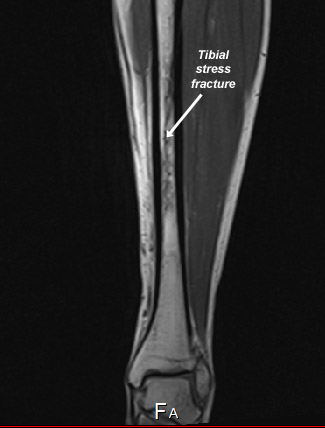Sports Podiatrist Sarah Bowling discusses Shin Splints (…or is it?)
Shin splints (also known as Medial Tibial Stress Syndrome – MTSS) can be described as pain along the shin bone, typically about 2/3 of the way down the leg. There can be pain with exercise, pain with rest or pain to push on that area.
Most commonly we will see a shin pain presentation with people who
– Have flat feet
– Are over training or overusing structures in the lower leg
– Doing repetitive activities like running, dancing, military training
– Wearing improper footwear such as unsupportive runners or shoes that are completely worn out
– Training on hard surfaces or up and down hill training
A full musculoskeletal and biomechanical examination is very important for the Podiatrist to correctly diagnose “Shin Splints” and differentiate MTSS from other lower leg pathologies that have a similar presentation such as…
-Exertional Compartment Syndrome. This is exercise or activity induced muscle and nerve pathology that causes pain, swelling or loss of motion of the lower leg. The Podiatrist may get you to run during the consult to try and recreate symptoms, pain or tenderness again. Imaging such as MRI can also give insight however, if imaging isn’t giving comprehensive enough answers the Podiatrist is also able to refer our patients to a Sport and Exercise Physician for Compartmental Pressure Studies. This assessment measures the pressure in the non-expansile space that results in reduced blood flow, nerve compression and muscle dysfunction.
– Tibialis Anterior Tendinopathy. Typically described as pain at the front of the shin when walking, running or doing activities like kicking a football with pointed toes. There will be pain to palpate along the length of the muscle and maybe even into the foot as Tibialis Anterior has attachment points there.
-Tibial Stress Fracture. These can develop gradually. Pain is focused and localised to one area and gets a lot worse with activity. The area may be red, hot or swollen and tender to touch
-Peripherial Nerve Entrapment. Irritation of a nerve in the lower leg. This can occur from tight shoe laces compressing nerves, fracture callus, a haematoma, or tumour. These peripheral nerves run in confines spaces so are easily aggravated or compressed
In order to rule out the above conditions Eastern Foot Care Sports Podiatrists conduct a thorough history including looking at the onset of the pain, the type of pain eg shooting, numbness, aching, stabbing, training regimens, footwear and foot mechanics. This is done in conjunction with a full biomechanical assessment to analyse gait patterns and provide further insight into causative mechanisms.
Imaging such an X-Ray, Ultrasound or MRI can be ordered by the Podiatrist and can help with differential diagnosis. CT and SPECT imaging may sometimes be required, and can be arranged in conjunction with a referral to an appropriate medial practitioner.
Treatment plans vary for “Shin Splints” and will depend on the actual diagnosis and underlying cause. As such we recommend patients suffering shin pain undergo a thorough and comprehensive assessment in order to formulate an appropriate treatment plan.
To make an appointment to see one of our Sports Podiatrists contact our friendly staff at:
Eastern Foot Care Ringwood
27 Wantirna Rd, RINGWOOD
Ph: (03) 9870 1301
Eastern Foot Care Knox
5a/426 Burwood Hwy, WANTIRNA SOUTH (Knox)
Ph: (03) 9887 2233

